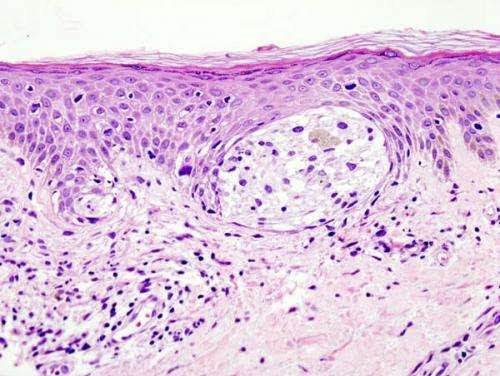JOHNS HOPKINS MEDICINE FOR IMMEDIATE RELEASE The U.S. Food and Drug Administration has approved a novel therapy for patients with metastatic or inoperable melanoma, an aggressive type of skin cancer. The treatment, developed based on original research conducted at the Johns Hopkins Kimmel Cancer Center, is comprised of two immunotherapy agents, relatlimab (anti-LAG-3) and nivolumab...
Tag: <span>MELANOMA</span>
Relatlimab Plus Nivolumab a ‘Game Changer’ in Advanced Melanoma
Megan Brooks January 05, 2022 For untreated advanced melanoma, the fixed-dose combination of relatlimab and nivolumab is a “game changer that we have been waiting 10 years for,” Hussein Tawbi, MD, PhD, University of Texas MD Anderson Cancer Center, Houston, told Medscape Medical News about today’s publication of the phase 2/3 RELATIVITY-047 trial. Progression-free survival (PFS) was “essentially double” with...
Researchers uncover insights into how moles change into melanoma
by Huntsman Cancer Institute Robert Judson-Torres, PhD. Credit: Huntsman Cancer Institute Moles and melanomas are both skin tumors that come from the same cell called melanocytes. The difference is that moles are usually harmless, while melanomas are cancerous and often deadly without treatment. In a study published today in eLife Magazine, Robert Judson-Torres, Ph.D., Huntsman Cancer...
New insights about melanocytes could lead to more targeted melanoma treatments
by Huntsman Cancer Institute Rachel Belote, PhD, and Robert Judson-Torres, PhD. Credit: Huntsman Cancer Institute Researchers at Huntsman Cancer Institute (HCI) at the University of Utah (U of U) have generated the first “atlas” of human melanocytes located throughout the body. In analyzing the atlas data further, the researchers discovered there are different types of melanocytes, including what...
Study reveals source of DNA mutations in melanoma
by Van Andel Research Institute Melanoma in skin biopsy with H&E stain — this case may represent superficial spreading melanoma. Credit: Wikipedia/CC BY-SA 3.0 The mutations that give rise to melanoma result from a chemical conversion in DNA fueled by sunlight—not just a DNA copying error as previously believed, reports a study by Van Andel Institute scientists published...
Cell-based immunotherapy shows promise against melanoma
by Julia Evangelou Strait, Washington University School of Medicine Three “memory-like” natural killer cells (red) attacking a melanoma cancer cell (green). The white areas show toxic molecules that the natural killer cells use to destroy the tumor cell. Credit: Nancy Marin/Fehniger Lab Immunotherapy based on supercharging the immune system’s natural killer cells has been effective in...
a deadly form of skin cancer — melanoma — alters the metabolism of healthy tissues elsewhere in the body
By Talia Ogliore May 13, 2021 A new study with zebrafish shows that a deadly form of skin cancer — melanoma — alters the metabolism of healthy tissues elsewhere in the body. The research from Washington University in St. Louis suggests that these other tissues could potentially be targeted to help treat cancer. Patti “Tumors rely on a constant...
Predicting mutated gene associated with melanoma
by Rae Lynn Mitchell, Texas A&M University Melanoma in skin biopsy with H&E stain — this case may represent superficial spreading melanoma. Credit: Wikipedia/CC BY-SA 3.0 Although risk for melanoma, the most serious type of skin cancer, is often associated with ultraviolet light exposure, genetic factors are also at play, with some families being more prone...
An amyloid link between Parkinson’s disease and melanoma
by American Chemical Society Immunofluorescence images show that some α-synuclein and Pmel17 are in the same locations in human melanoma cells. Credit: Dexter Dean, Ph.D. On the surface, Parkinson’s disease—a neurodegenerative disorder—and melanoma—a type of skin cancer—do not appear to have much in common. However, for nearly 50 years, doctors have recognized that Parkinson’s disease patients...
An artificial intelligence tool that can help detect melanoma
Using deep convolutional neural networks, researchers devise a system that quickly analyzes wide-field images of patients’ skin in order to more efficiently detect cancer. Melanoma is a type of malignant tumour responsible for more than 70 per cent of all skin cancer-related deaths worldwide. For years, physicians have relied on visual inspection to identify suspicious pigmented lesions...








